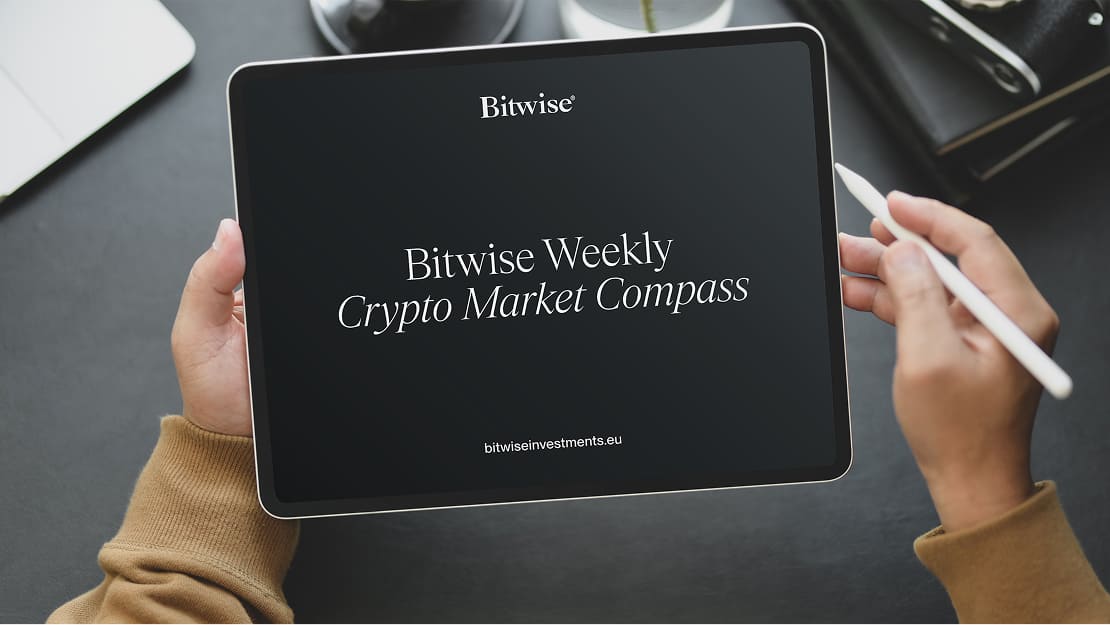- Last week, cryptoassets outperformed traditional assets again as risk appetite returned and a potential rotation from gold to bitcoin appeared to be underway.
- Our Cryptoasset Sentiment Index has turned slightly bullish again. The improvement in cryptoasset sentiment is largely reflective of bullish sentiment in BTC derivatives markets -- significant BTC call buying, short futures liquidations, positive skew, and increasing funding rates have driven sentiment higher.
- Chart of the Week: Fed easing announcements alone have led to significant increases in inflation expectations (CPI swaps) due to higher anticipated liquidity growth. Markets tend to anticipate the monetary policy action itself well in advance which also bodes well for scarce cryptoassets like bitcoin.
Chart of the Week
Fed monetary policy easing announcements alone have led to significant increases in inflation expectations
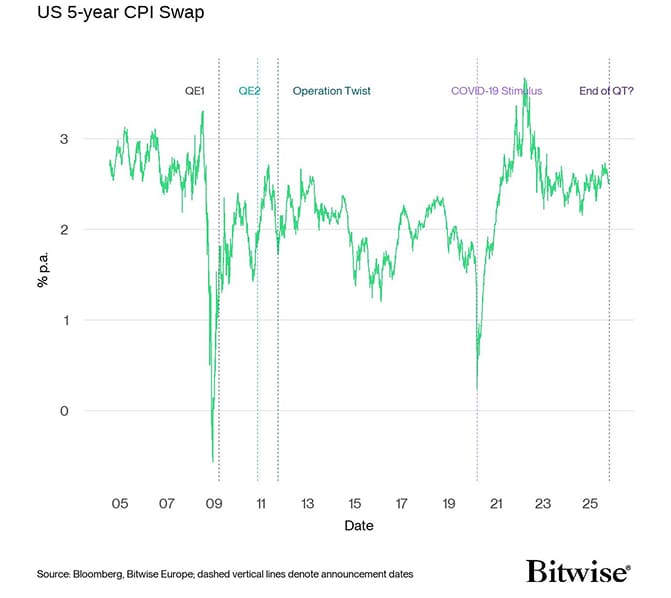
Performance
Last week, cryptoassets outperformed traditional assets again as risk appetite returned and a potential rotation from gold to bitcoin appeared to be underway.
More specifically, bitcoin outperformed gold by around +860 basis points last week. In our previous Crypto Market Compass report, we highlighted that only a small capital rotation from gold to bitcoin could have very significant performance effects on the price of bitcoin due to the sheer size of the gold market.
We think that this capital rotation is likely to continue especially considering a return in risk-on sentiment due to a general recovery of the (US) business cycle which tends to support risk assets like bitcoin. As highlighted here, improving cross asset risk appetite tends to be associated with an outperformance of bitcoin vis-à-vis gold.
The return in global risk appetite is supported by ongoing monetary policy easing by central banks worldwide, in particular the Fed. In fact, the number of global rate cuts past 24 months is already higher than after Covid. Net interest rate cuts by major central banks imply an ongoing improvement in the US business cycle which should bode very well for global risk appetite.
This improvement in global risk appetite already appears to be underway as our in-house Cryptoasset Sentiment Index has turned slightly bullish again. The improvement in cryptoasset sentiment is largely reflective of bullish sentiment in BTC derivatives markets -- significant BTC call buying, short futures liquidations, positive skew, and increasing funding rates have driven sentiment higher.
Moreover, the FOMC is about to convene on the 29th of October this week. At the time of writing this report on Monday morning, Fed Funds Futures price in around a 97% chance for another rate cut of 25 bps this month and 98% probability for another 25 bps until year-end (50 bps in total).
Furthermore, major banks like Bank of America and JP Morgan are expecting the Fed to end Quantitative Tightening (“QT”) this month, i.e. end the run-down of the Fed's bond holdings and eventually return to buying bonds and providing liquidity again.
The key to understand is that Fed easing announcements alone have led to significant increases in inflation expectations (CPI swaps) due to higher anticipated liquidity growth (Chart-of-the-Week). Markets tend to anticipate the monetary policy action itself well in advance.
The announced end of QT would most likely lead to a renewed acceleration in inflation expectations and, by derivation, a decline in real yields signalling significant easing in financial conditions which usually bodes well for scarce cryptoassets like bitcoin as highlighted in our latest Bitcoin Macro Investor report.
A positive development in the US-China trade spat could also brighten risk appetite even further.
In any case, we continue to expect an improvement in global growth expectations and risk appetite due to ongoing monetary policy easing which should prolong the current bull market in bitcoin and cryptoassets well into 2026.
Cross Asset Performance (Week-to-Date)
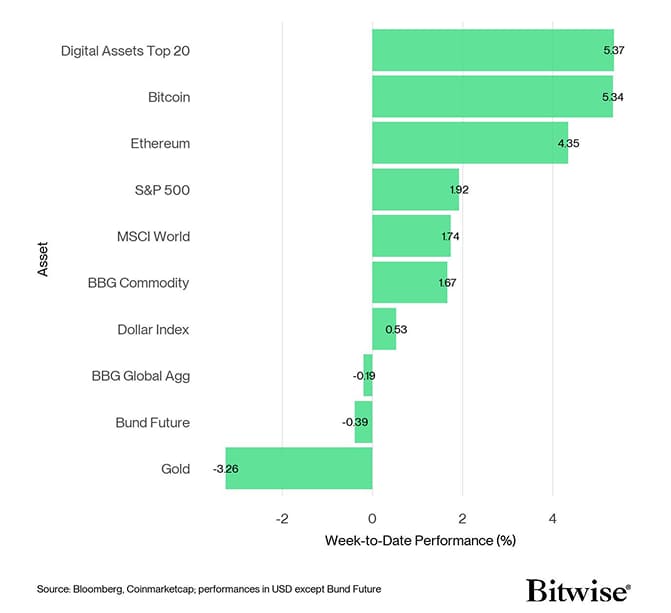 Source: Bloomberg, Coinmarketcap; performances in USD exept Bund Future
Top 10 Cryptoasset Performance (Week-to-Date)
Source: Bloomberg, Coinmarketcap; performances in USD exept Bund Future
Top 10 Cryptoasset Performance (Week-to-Date)
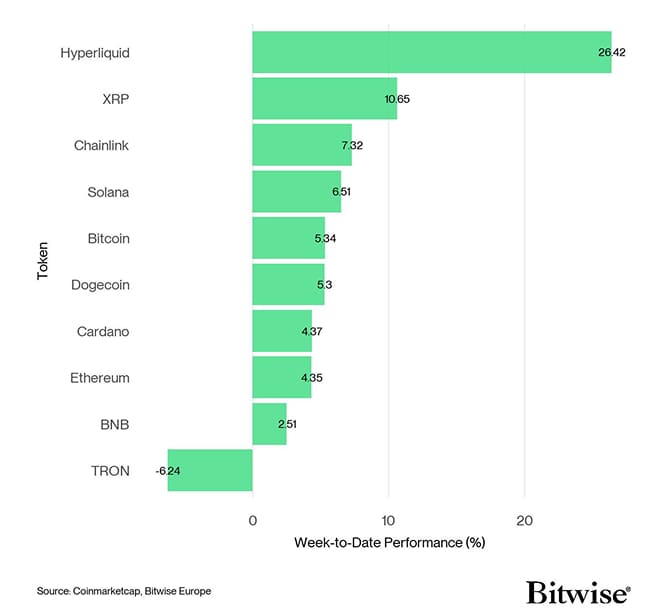 Source: Coinmarketcap
Source: Coinmarketcap
In general, among the top 10 crypto assets Hyperliquid, XRP, and Chainlink were the relative outperformers.
Overall, altcoin outperformance vis-à-vis bitcoin has continued to be low last week, with only 30% of our tracked altcoins managing to outperform bitcoin on a weekly basis. Ethereum also slightly underperformed bitcoin last week.
Sentiment
Our in-house “Cryptoasset Sentiment Index” has exhibited very bearish sentiment until Sunday when it finally flipped back positive.
At the moment, 7 out of 15 indicators are above their short-term trend, an increase from only 3, the week prior.
Last week, Bitcoin Exchange outflows, Put-Call volume, Long Futures Liquidation Dominance, 1Month 25D Skew, Funding Rate, STH SOPR and Crypto Hedge Fund Beta metrics showed positive momentum.
The Crypto Fear & Greed Index currently signals a “Neutral” level of sentiment as of this morning. This change is not uncommon as the index has spent the majority of the last month in between “Neutral” and “Fear”.
Performance dispersion among cryptoassets has trended up slightly last week, signalling that while altcoins have continued to be highly correlated with the performance of bitcoin, this is a metric to keep an eye on.
Altcoin outperformance vis-à-vis Bitcoin has increased from last week, with around 30% of our tracked altcoins managing to outperform Bitcoin on a weekly basis. Yet, Ethereum underperformed Bitcoin last week.
In general, increasing (decreasing) altcoin outperformance tends to be a sign of increasing (decreasing) risk appetite within cryptoasset markets and the latest altcoin outperformance signals an increasing risk appetite at the moment.
Sentiment in traditional financial markets as measured by our in-house measure of Cross Asset Risk Appetite (CARA) has also increased, moving from 0.1 to 0.44. This is a notable divergence between tradfi and crypto asset sentiment that should be watched closely.
Fund Flows
While weekly fund flows into global crypto ETPs continued to decelerate last week, inflows across Bitcoin and “Basket & Thematic” products still suggest steady allocation. This coincides with a slight rise in performance dispersion, indicating that correlations remain high, but divergences are beginning to widen.
Global crypto ETPs saw around +416.1 mn USD in weekly net inflows across all types of cryptoassets, after +1699.6 mn USD in net inflows the previous week.
Global Bitcoin ETPs have continued to experience net inflows totalling +532.6 mn USD last week, of which +446.4 mn USD in net inflows were related to US spot Bitcoin ETFs.
The Bitwise Bitcoin ETF (BITB) in the US experienced net inflows, totalling +39.5 mn USD last week.
In Europe, the Bitwise Physical Bitcoin ETP (BTCE) experienced net inflows equivalent to +0.3 mn USD, while the Bitwise Core Bitcoin ETP (BTC1) experienced minor net inflows of +8.6 mn USD.
The Grayscale Bitcoin Trust (GBTC) has posted net outflows of -117.1 mn USD. The iShares Bitcoin Trust (IBIT), however, experienced net inflows of around +324.3 mn USD last week.
Meanwhile, flows into global Ethereum ETPs flipped negative last week, with around -177.3 mn USD in net outflows.
US spot Ethereum ETFs, also recorded net outflows of around -243.9 mn USD on aggregate. The Grayscale Ethereum Trust (ETHE), has posted net outflows of -26 mn USD.
The Bitwise Ethereum ETF (ETHW) in the US has also posted net outflows of -8.8 mn USD.
In Europe, the Bitwise Physical Ethereum ETP (ZETH) saw net outflows of -9.7 mn USD while the Bitwise Ethereum Staking ETP (ET32) saw minor net inflows of +4.2 mn USD.
Altcoin ETPs ex Ethereum also experienced net outflows of -5.7 mn USD last week.
Thematic & basket crypto ETPs, however, posted net inflows of +66.6 mn USD on aggregate last week. The Bitwise MSCI Digital Assets Select 20 ETP (DA20) has experienced zero flows (+/- 0 mn USD) on aggregate.
Global crypto hedge funds exposure to Bitcoin has decreased slightly last week. The 20-days rolling beta of global crypto hedge funds' performance to Bitcoin decreased to around 0.66 per yesterday's close, down from 0.68 from the week before.
On-Chain Data
Sell-side pressure has declined meaningfully, with intraday spot buying minus selling closing the week at approximately –$835.5M, down from –$2.46B last week. This indicates that net spot selling has eased substantially, even though flows remain marginally negative overall.
Bitcoin whales (entities holding at least 1k BTC) remain largely inactive, with HODLing and distribution broadly in balance. This neutral posture suggests a degree of uncertainty across the cohort as the market continues to search for directional clarity.
Furthermore, based on recent data from Glassnode, the overall downward trend in exchange-held Bitcoin reserves remains intact. The current level stands at 2.863 million BTC, representing approximately 14.4% of the total circulating supply, a 30 bps increase from last week.
The market is showing notable signs of recovery, having reclaimed both the 200-day moving average at $109k and the Short-Term Holder cost basis at $113k. This places a large share of recent investors back into a position of profit, improving sentiment and reducing near-term sell pressure. Maintaining this level is now critical for sustaining upward momentum.
Additionally, the Accumulation Trend Score, which measures changes in supply held across wallets of all sizes, shows that accumulation pressure remains robust. Notably, wallets ranging from less than 1 BTC up to 1k BTC are net accumulators, indicating broad-based dip-buying across both retail and large holders.
All in all, on-chain conditions continue to signal a constructive backdrop, supported by moderating sell-side pressure and a meaningful improvement in market structure. The reclaiming of both the 200-day moving average and the Short-Term Holder cost basis has returned a large share of recent investors to profit, helping stabilise sentiment, while accumulation remains strong across both retail and large holders. However, these levels now act as key support and must be maintained for further price appreciation, as losing them would risk undermining the recovery and returning the market to a more defensive posture.
Futures, Options & Perpetuals
Over the past week, BTC perpetual futures open interest remained largely static, increasing by only +45 BTC across all exchanges. However, open interest across CME futures contracts increased by +4335 BTC, signalling a modest uptick in institutional participation. However, in aggregate, futures positioning suggests that traders remain cautious in the aftermath of the recent deleveraging event, opting to scale back risk until clearer directional momentum re-emerges.
Despite open interest remaining flat, BTC perpetual funding rates have flipped from net-neutral back into positive territory, reflecting a growing long bias as the market shows signs of recovery. The level of funding is broadly in line with prior constructive market conditions, indicating a return of cautious optimism rather than speculative excess.
In general, when the funding rate is positive (negative), long (short) positions periodically pay short (long) positions, which is indicative of bullish (bearish) sentiment.
The BTC 3-months annualised basis remained unchanged at 6.8% p.a., averaged across various futures exchanges.
BTC options open interest has increased by approximately +3.9k BTC and remains just below its all-time high, while the put–call open interest ratio holds steady at 0.66. This indicates that demand for downside protection remains elevated, reflecting continued uncertainty around market direction despite the recovery in positioning.
Meanwhile, the 25-delta skew across major BTC option tenors has started to decline, suggesting that although hedging appetite remains present, the price of downside protection is easing. The elevated put/call open interest highlights that traders remain cautious, however, the declining skew suggests the urgency to pay a premium for protection has moderated.
In addition, implied volatilities have fallen across all tenors, signalling that the market is repricing volatility lower overall, even as downside positioning remains elevated
Bottom Line
- Last week, cryptoassets outperformed traditional assets again as risk appetite returned and a potential rotation from gold to bitcoin appeared to be underway.
- Our Cryptoasset Sentiment Index has turned slightly bullish again. The improvement in cryptoasset sentiment is largely reflective of bullish sentiment in BTC derivatives markets -- significant BTC call buying, short futures liquidations, positive skew, and increasing funding rates have driven sentiment higher.
- Chart of the Week: Fed easing announcements alone have led to significant increases in inflation expectations (CPI swaps) due to higher anticipated liquidity growth. Markets tend to anticipate the monetary policy action itself well in advance which also bodes well for scarce cryptoassets like bitcoin.
Appendix
Bitcoin Price vs Cryptoasset Sentiment Index
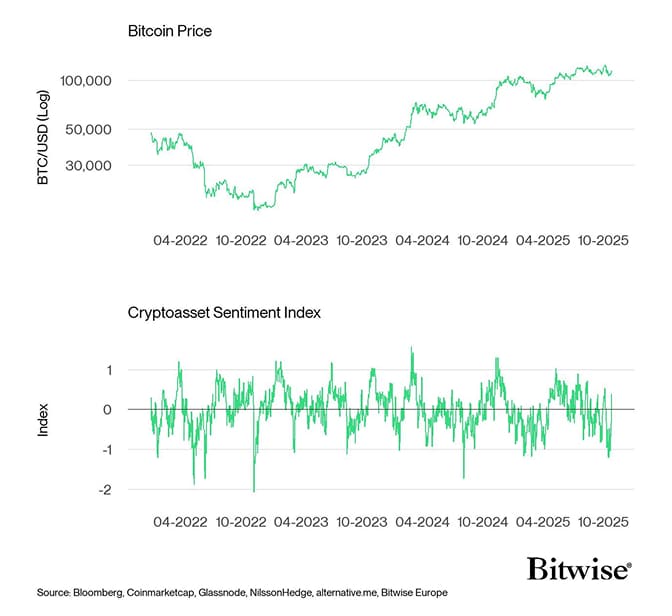 Source: Bloomberg, Coinmarketcap, Glassnode, NilssonHedge, alternative.me, Bitwise Europe
Cryptoasset Sentiment Index
Source: Bloomberg, Coinmarketcap, Glassnode, NilssonHedge, alternative.me, Bitwise Europe
Cryptoasset Sentiment Index
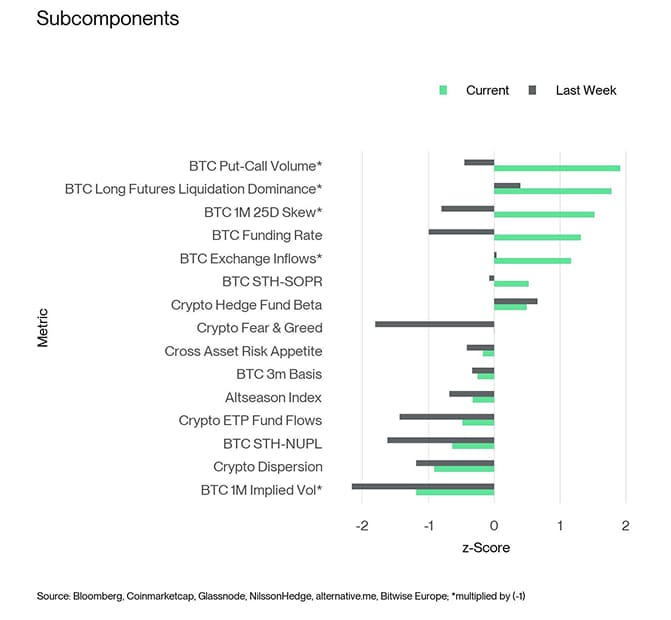 Source: Bloomberg, Coinmarketcap, Glassnode, NilssonHedge, alternative.me, Bitwise Europe; *multiplied by (-1)
Cryptoasset Sentiment Index
Source: Bloomberg, Coinmarketcap, Glassnode, NilssonHedge, alternative.me, Bitwise Europe; *multiplied by (-1)
Cryptoasset Sentiment Index
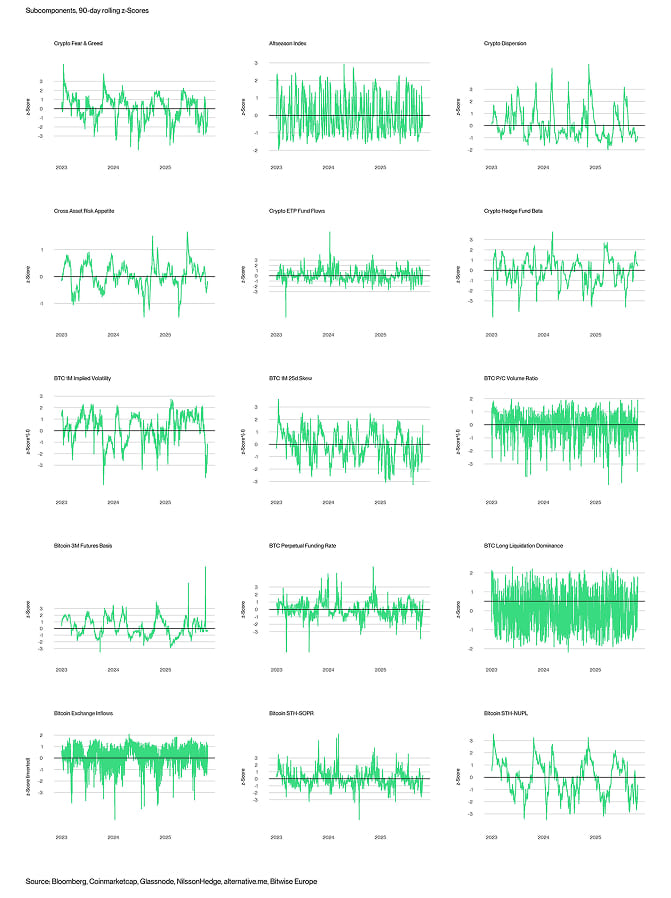 Source: Bloomberg, Coinmarketcap, Glassnode, NilssonHedge, alternative.me, Bitwise Europe
TradFi Sentiment Indicators
Source: Bloomberg, Coinmarketcap, Glassnode, NilssonHedge, alternative.me, Bitwise Europe
TradFi Sentiment Indicators
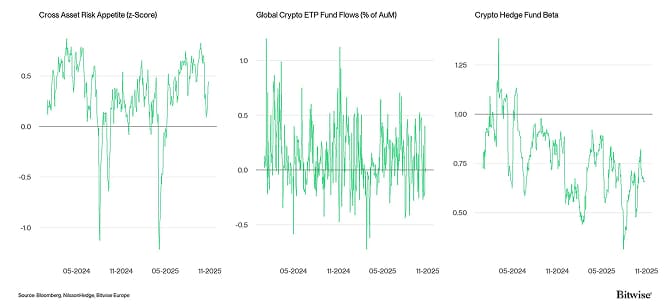 Source: Bloomberg, NilssonHedge, Bitwise Europe
Crypto Sentiment Indicators
Source: Bloomberg, NilssonHedge, Bitwise Europe
Crypto Sentiment Indicators
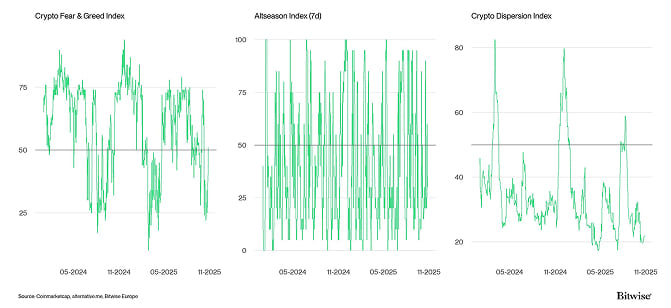 Source: Coinmarketcap, alternative.me, Bitwise Europe
Crypto Options' Sentiment Indicators
Source: Coinmarketcap, alternative.me, Bitwise Europe
Crypto Options' Sentiment Indicators
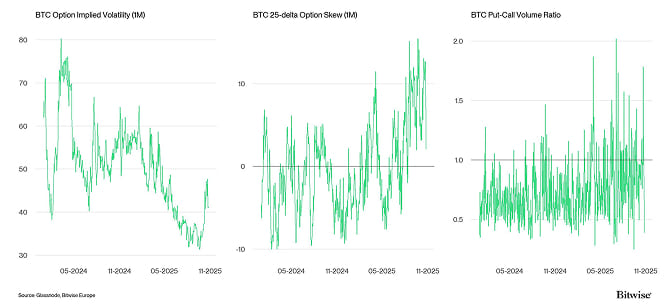 Source: Glassnode, Bitwise Europe
Crypto Futures & Perpetuals' Sentiment Indicators
Source: Glassnode, Bitwise Europe
Crypto Futures & Perpetuals' Sentiment Indicators
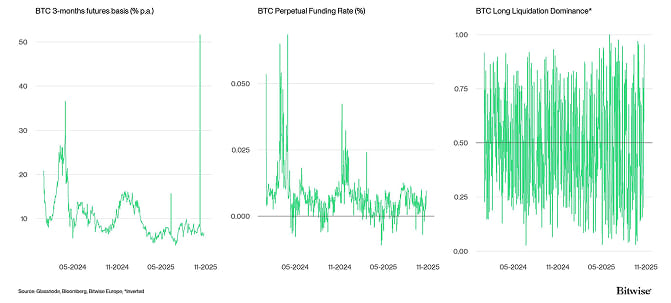 Source: Glassnode, Bitwise Europe; *Inverted
Crypto On-Chain Indicators
Source: Glassnode, Bitwise Europe; *Inverted
Crypto On-Chain Indicators
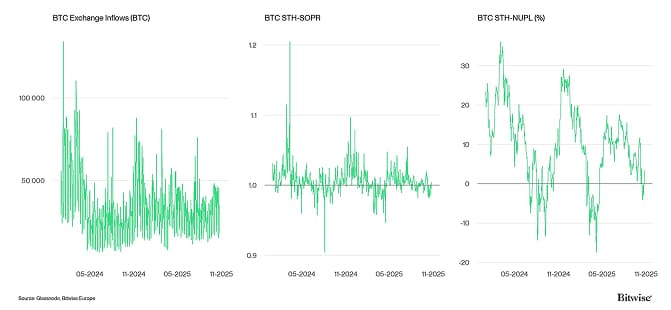 Source: Glassnode, Bitwise Europe
Bitcoin vs Crypto Fear & Greed Index
Source: Glassnode, Bitwise Europe
Bitcoin vs Crypto Fear & Greed Index
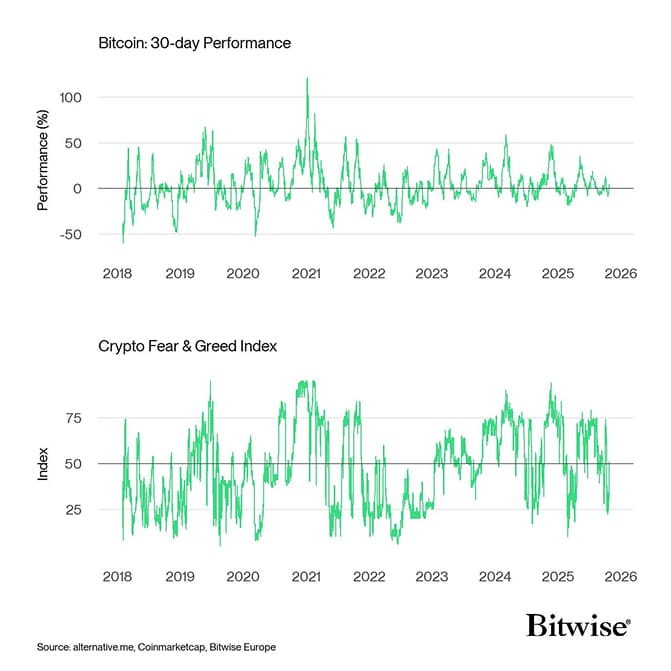 Source: alternative.me, Coinmarketcap, Bitwise Europe
Cryptoasset Sentiment Index: Daily vs Hourly
Source: alternative.me, Coinmarketcap, Bitwise Europe
Cryptoasset Sentiment Index: Daily vs Hourly
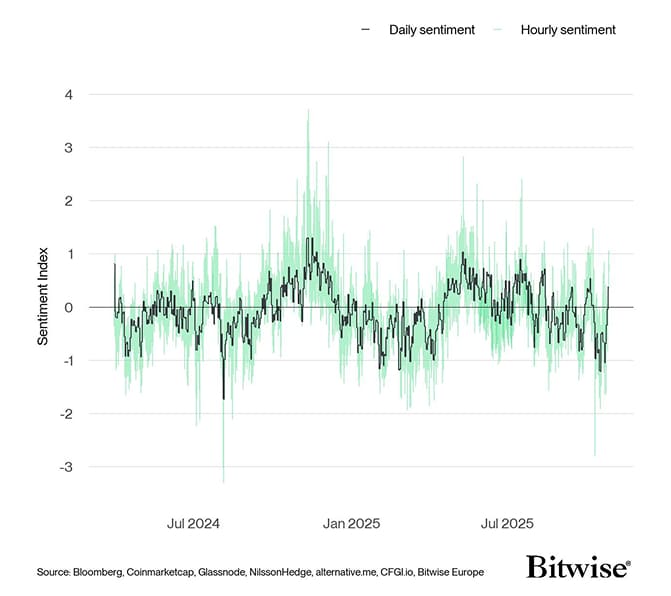 Source: Bloomberg, Coinmarketcap, Glassnode, NilssonHedge, alternative.me, CFGI.io, Bitwise Europe
Bitcoin vs Global Crypto ETP Fund Flows
Source: Bloomberg, Coinmarketcap, Glassnode, NilssonHedge, alternative.me, CFGI.io, Bitwise Europe
Bitcoin vs Global Crypto ETP Fund Flows
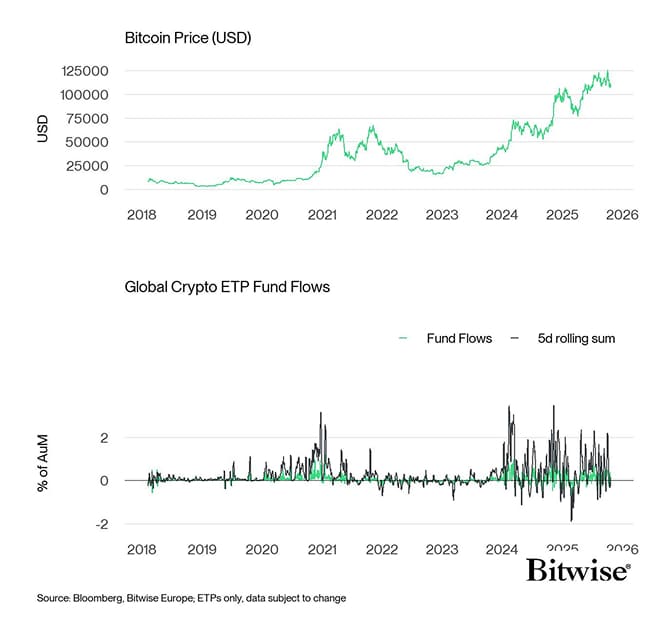 Source: Bloomberg, Bitwise Europe; ETPs only, data subject to change
Global Crypto ETP Fund Flows
Source: Bloomberg, Bitwise Europe; ETPs only, data subject to change
Global Crypto ETP Fund Flows
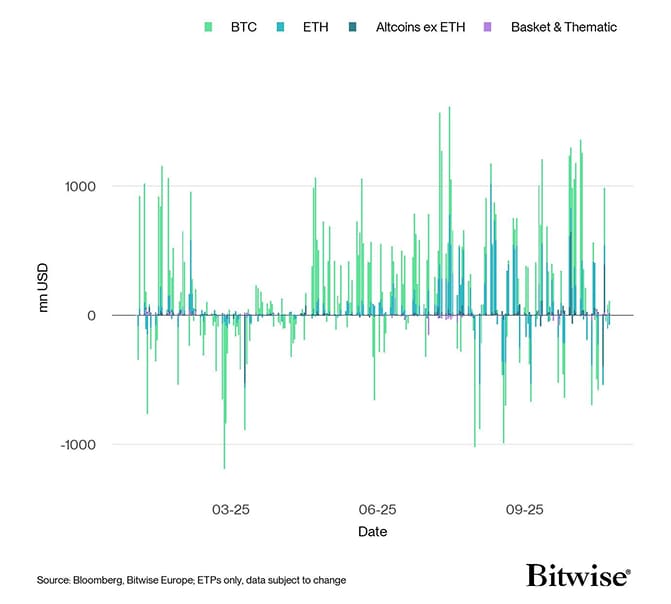 Source: Bloomberg, Bitwise Europe; ETPs only; data subject to change
US Spot Bitcoin ETF Fund Flows
Source: Bloomberg, Bitwise Europe; ETPs only; data subject to change
US Spot Bitcoin ETF Fund Flows
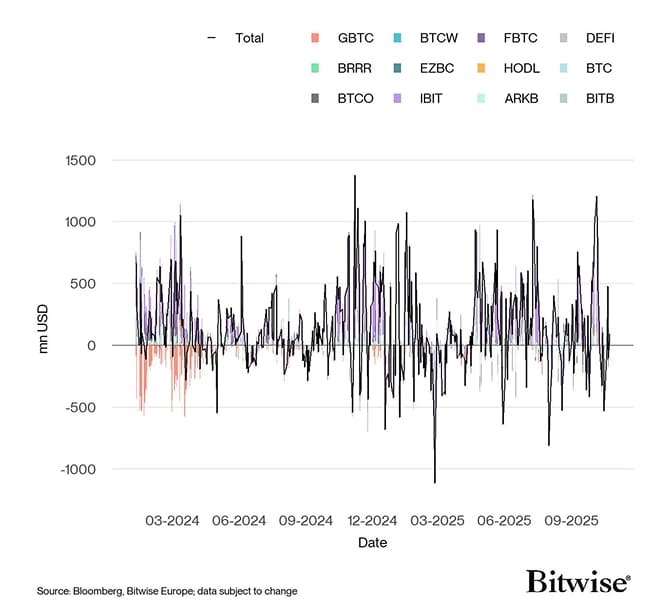 Source: Bloomberg, Bitwise Europe; data subject to change
US Spot Bitcoin ETFs: Flows since launch
Source: Bloomberg, Bitwise Europe; data subject to change
US Spot Bitcoin ETFs: Flows since launch
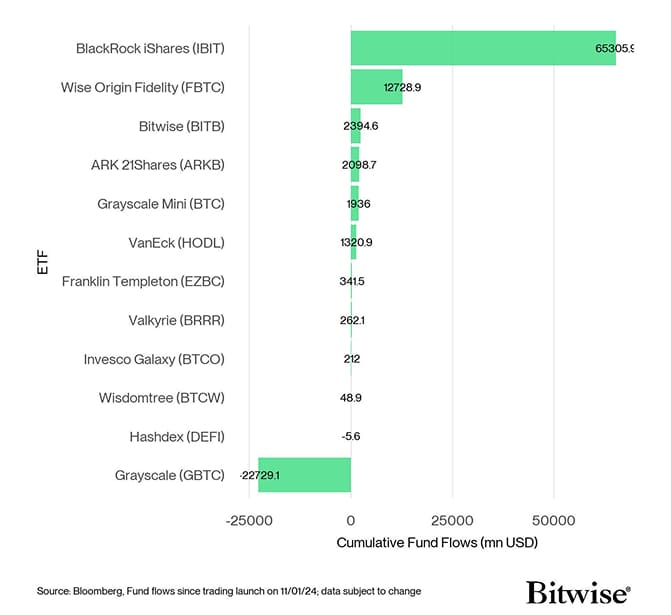 Source: Bloomberg, Fund flows since traiding launch on 11/01/24; data subject to change
US Spot Bitcoin ETFs: 5-days flow
Source: Bloomberg, Fund flows since traiding launch on 11/01/24; data subject to change
US Spot Bitcoin ETFs: 5-days flow
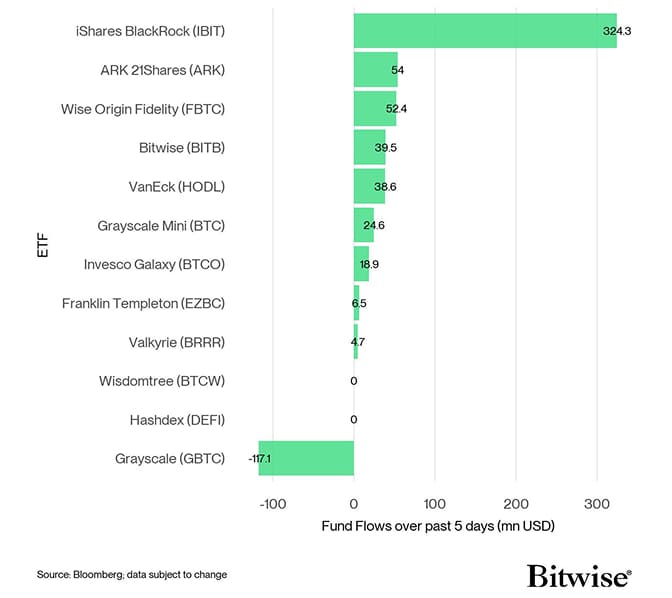 Source: Bloomber; data subject to change
US Bitcoin ETFs: Net Fund Flows since 11th Jan mn USD
Source: Bloomber; data subject to change
US Bitcoin ETFs: Net Fund Flows since 11th Jan mn USD
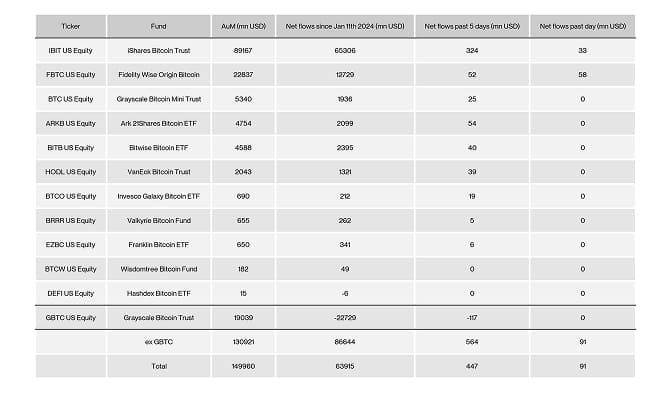 Source: Bloomberg, Bitwise Europe; data as of 24-10-2025
US Spot Ethereum ETF Fund Flows
Source: Bloomberg, Bitwise Europe; data as of 24-10-2025
US Spot Ethereum ETF Fund Flows
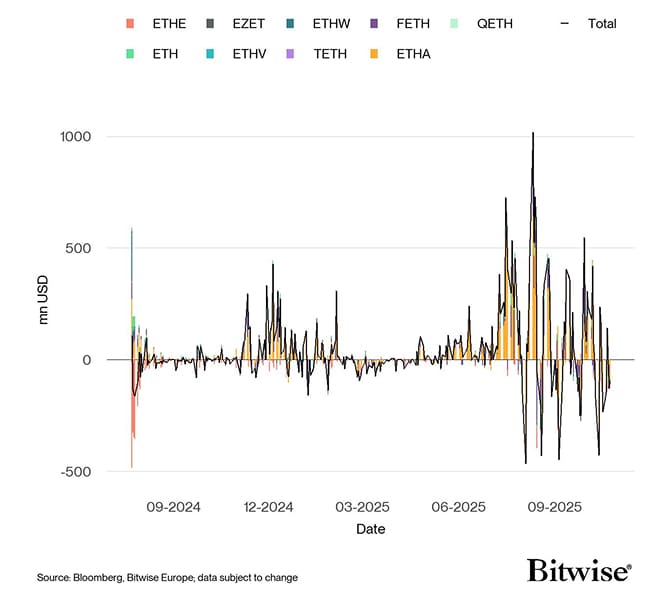 Source: Bloomberg, Bitwise Europe; data subject to change
US Spot Ethereum ETFs: Flows since launch
Source: Bloomberg, Bitwise Europe; data subject to change
US Spot Ethereum ETFs: Flows since launch
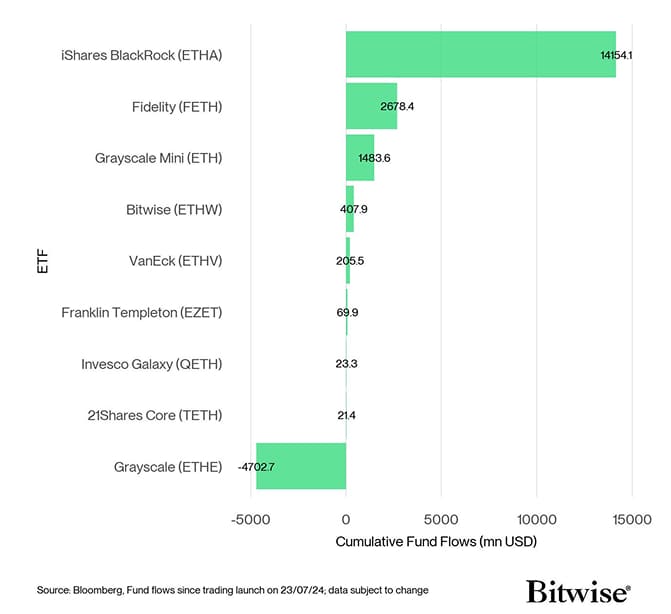 Source: Bloomberg, Fund flows since trading launch on 23/07/24; data subject on change
US Spot Ethereum ETFs: 5-days flow
Source: Bloomberg, Fund flows since trading launch on 23/07/24; data subject on change
US Spot Ethereum ETFs: 5-days flow
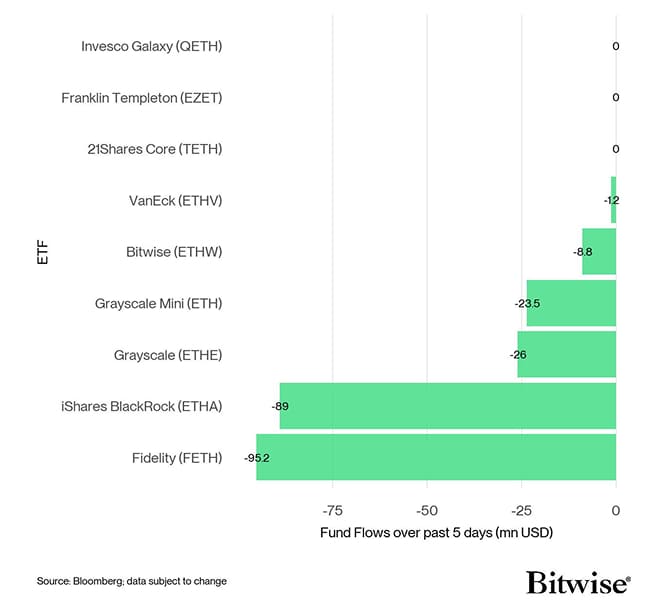 Source: Bloomberg; data subject on change
US Ethereum ETFs: Net Fund Flows since 23rd July
Source: Bloomberg; data subject on change
US Ethereum ETFs: Net Fund Flows since 23rd July
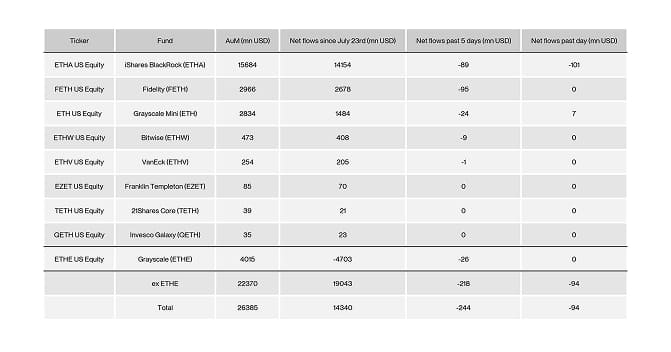 Source: Bloomberg, Bitwise Europe; data as of 24-10-2025
Bitcoin vs Crypto Hedge Fund Beta
Source: Bloomberg, Bitwise Europe; data as of 24-10-2025
Bitcoin vs Crypto Hedge Fund Beta
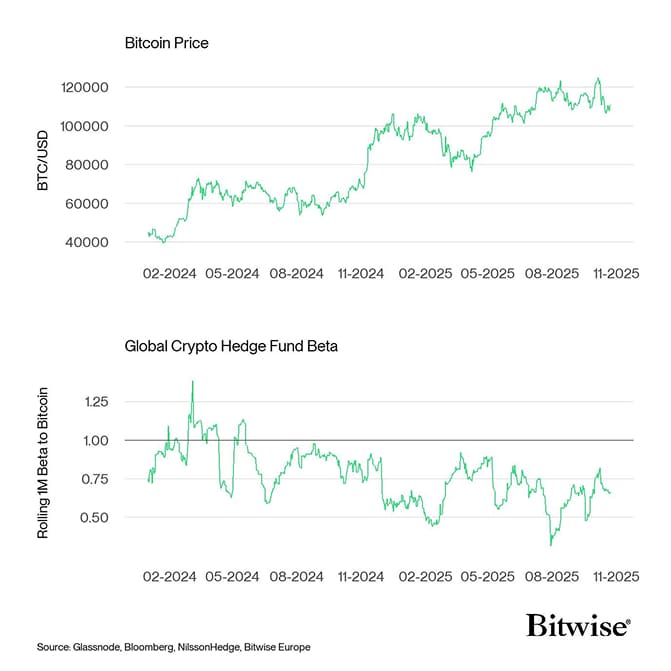 Source: Glassnode, Bloomberg, NilssonHedge, Bitwise Europe
Altseason Index
Source: Glassnode, Bloomberg, NilssonHedge, Bitwise Europe
Altseason Index
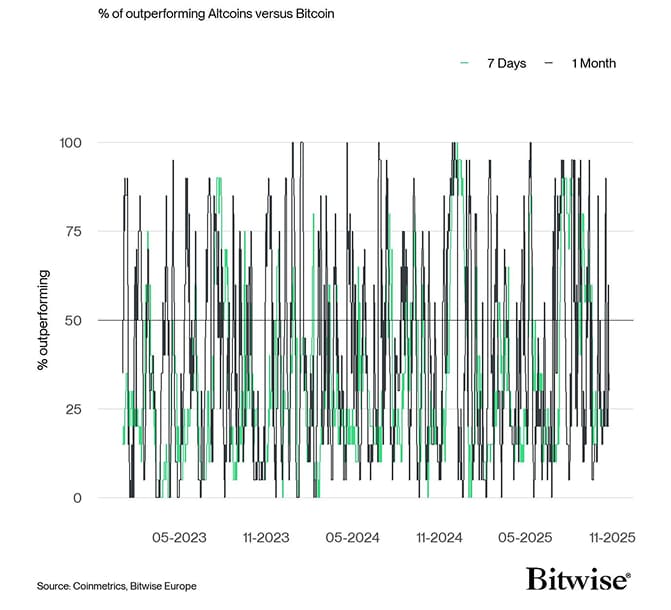 Source: Coinmetrics, Bitwise Europe
Bitcoin vs Crypto Dispersion Index
Source: Coinmetrics, Bitwise Europe
Bitcoin vs Crypto Dispersion Index
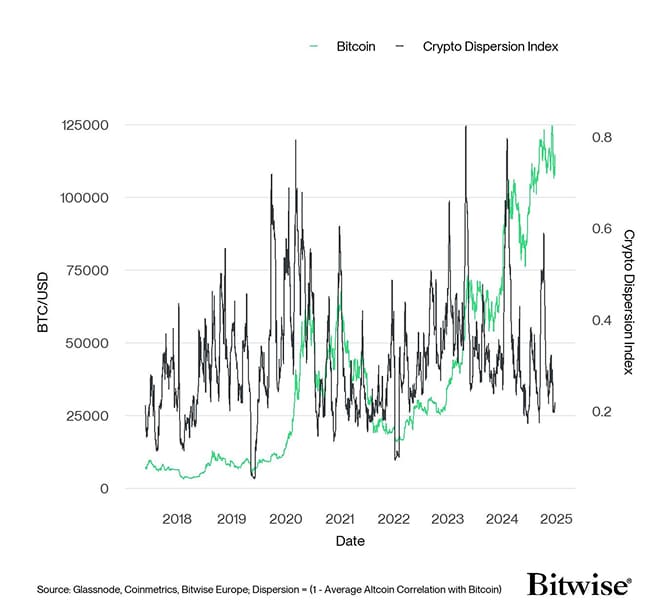 Source: Coinmarketcap, Bitwise Europe; Dispersion = (1 - Average Altcoin Correlation with Bitcoin)
Bitcoin Price vs Futures Basis Rate
Source: Coinmarketcap, Bitwise Europe; Dispersion = (1 - Average Altcoin Correlation with Bitcoin)
Bitcoin Price vs Futures Basis Rate
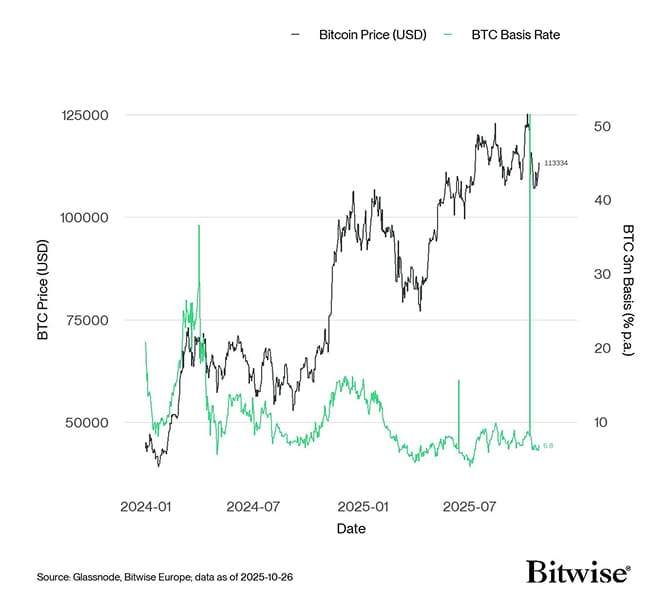 Source: Glassnode, Bitwise Europe; data as of 2025-10-26
Ethereum Price vs Futures Basis Rate
Source: Glassnode, Bitwise Europe; data as of 2025-10-26
Ethereum Price vs Futures Basis Rate
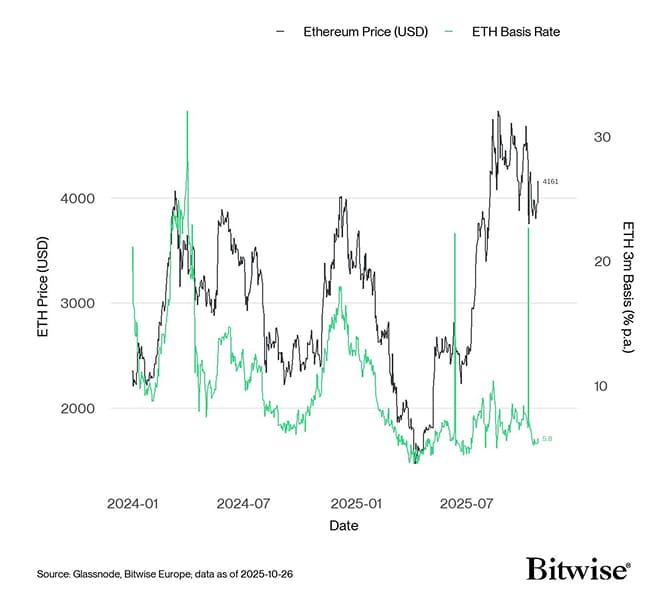 Source: Glassnode, Bitwise Europe; data as of 2025-10-26
BTC Net Exchange Volume by Size
Source: Glassnode, Bitwise Europe; data as of 2025-10-26
BTC Net Exchange Volume by Size
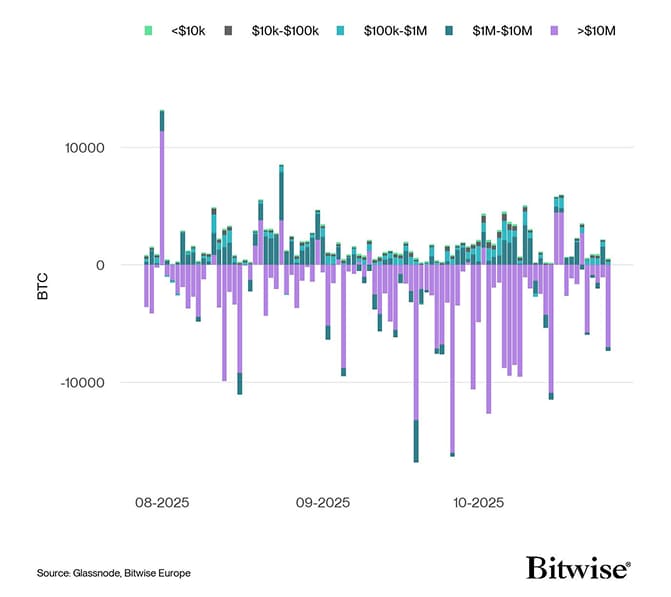 Source: Glassnode, Bitwise Europe
Source: Glassnode, Bitwise Europe
Important information:
This article does not constitute investment advice, nor does it constitute an offer or solicitation to buy financial products. This article is for general informational purposes only, and there is no explicit or implicit assurance or guarantee regarding the fairness, accuracy, completeness, or correctness of this article or the opinions contained therein. It is advised not to rely on the fairness, accuracy, completeness, or correctness of this article or the opinions contained therein. Please note that this article is neither investment advice nor an offer or solicitation to acquire financial products or cryptocurrencies.
Before investing in crypto ETPs, potentional investors should consider the following:
Potential investors should seek independent advice and consider relevant information contained in the base prospectus and the final terms for the ETPs, especially the risk factors mentioned therein. The invested capital is at risk, and losses up to the amount invested are possible. The product is subject to inherent counterparty risk with respect to the issuer of the ETPs and may incur losses up to a total loss if the issuer fails to fulfill its contractual obligations. The legal structure of ETPs is equivalent to that of a debt security. ETPs are treated like other securities.
